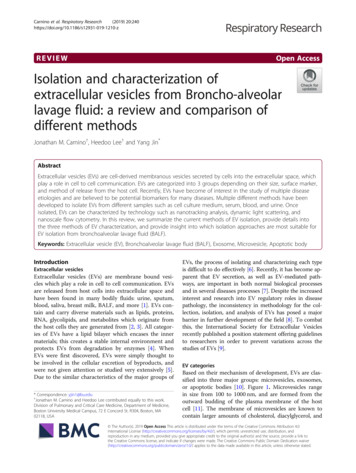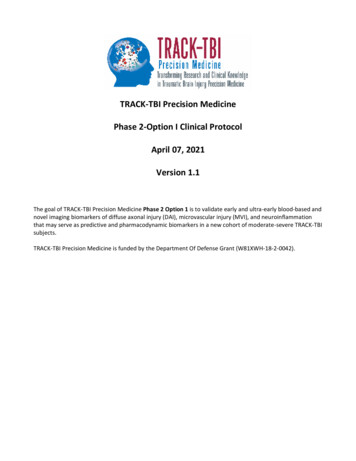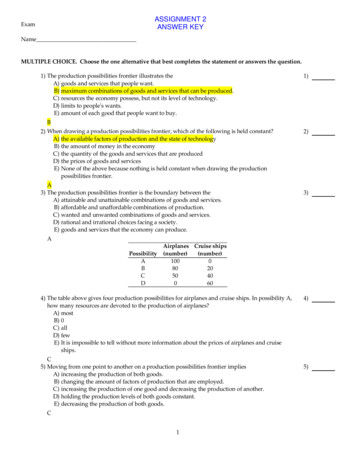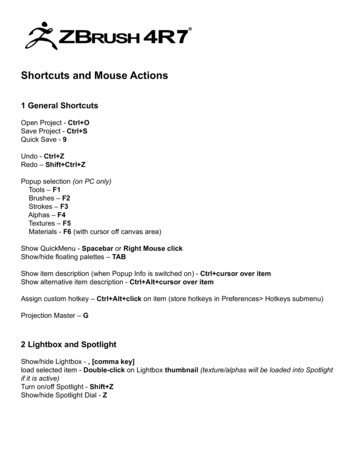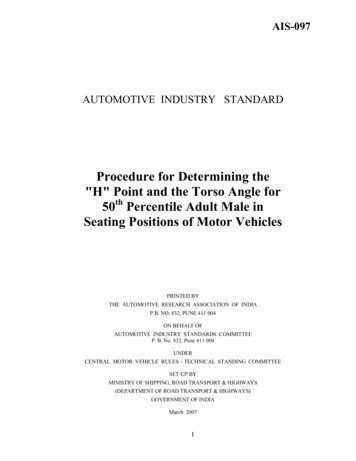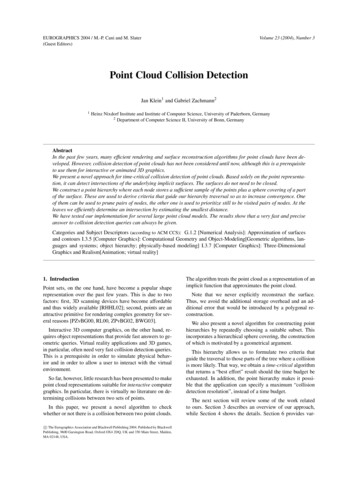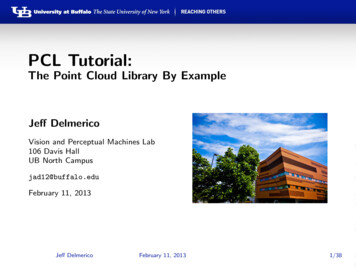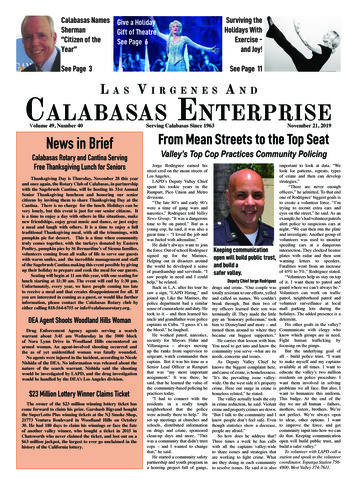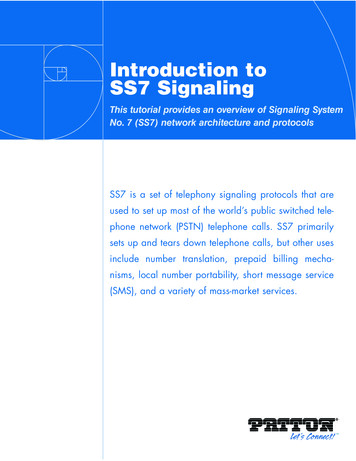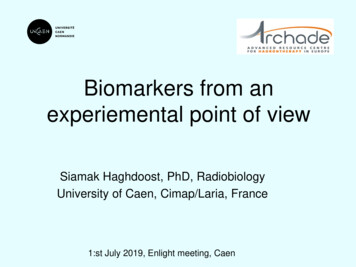
Transcription
Biomarkers from anexperiemental point of viewSiamak Haghdoost, PhD, RadiobiologyUniversity of Caen, Cimap/Laria, France1:st July 2019, Enlight meeting, Caen
Biomarker:Any measurement reflecting an interaction between a biological system andan environmental agent, which may be chemical, physical or biological.Considering radiation: Biomarkers can be used for multiple purposes:––––Estimation or validation of received doseInvestigation of correlation between exposure and biological responses e.g.,therapeutic effects of radiotherapyInvestigation of individual susceptibilityEarly detection of a radiation induced health effect
Retrospective or prospective cohorts
Example of biomarker for monitoringeffect of treatment:Serum level of thymidine kinase 1
1951: TK1 was discovered by Prof Peter Richard and hisresearch groupLate 1954: TK1 was suggested as a proliferation/growth marker intumour biopsy1986 – 2000: developed a sensitive TK1 test for detect of TK1 inhuman blood serum2002: SSTK company was set up to produce TK1 kit
TK1 in relation to DNA-synthesis and the cell cycleTK1G1DNAsyhthesisSG2 M
Gastric, monitoring chemo-therapy1 monthbefore2 monthsSerum TK1 (pM)1612840CRPRSDPDCR: complete remission,PR: partial remission, 50% of tumor disappear.SD: stable diseases, the tumor size did not change.PD: progressive diseases, tumor size increase.
Gastric, survival1.0Low STK1Overall survival0.80.6High STK10.40.2p 0.00404681012141618MonthsSimilar results:Breast cancer survivalHodgkin diseaseProstate cancer
Colorectal, survival504 patients1.0TK1 lowSurvival0.80.6TK1 high0.40.200020406080MonMonthsths100120140
STK11. Prognosis of patient survival: High or low levels before treatment2. Early diagnosis of Relapse: Increase level after treatment indicaterelapse3.Results of treatment: Decreasing level after treatment4.Health screening of pre-tumor and early small tumor(low TK1 value, good prognosis)
Ongoing experiments to find biomarker ofindividual radiosensitivity: 1999-7 PhD students20 Master students3 Post docs35 Publications
Healthy tissue reaction in radiotherapyIncreasing incidencedue to long-term survivorsBernett, G, et. al. 2009
Factors influenzing side effects Dose per fraction/dose rateTotal doseTarget volume and irradiated organRadiation quality Life style Health status Individual radiosensitivity: genetic background
Normal distribution of tissue reactions to radiotherapySelection of cohorts:Burnet et al, Int. J. Cancer, 1998, 79, 606
Radiation sensitivity About 60 percent of all cancer patients receiveradiotherapy Approximately 20% of RT patients experienceadverse effects and 3-5% experience severeadverse effects are accepted The dose is adjusted to the most sensitive individuals
Longterm aim:To have predictive assay to be able todistinguish between extreme sensitive andnormal senstive patients perior radiotherapyFocus is healthy tissue side effect as dose limiting factor
Nomber of DNA damade per Gy/cell1 Gy photon 20-40 DSB» 1000 SSB» 2000 Base damages»
Radiosensitivty of DNA repair deficient cells
Base exicision repair pathway*Ex 8-oxo-G with hOGG1Out from body viaurine and saliva* Damaged base
HypothsisNormo-sensensitive patients has better DNA repair, BER, capacity.If 2 individual with different DNA repair capacities receive same dose:Lower 8-oxo-dG should be detected in radiosensitive patients afterirradiation as compared to normo-sensitive individual
Can urinary 8-oxo-dG be used as apredictor for individual radiosensitivity?Haghdoost s. et al Intl. J. of Radiation Oncology, Biology, Physics, Patients17 breast cancer patients, radiotherapyafter surgery (46 Gy with 2 Gy fractions) tobreast and regional lymph nodesMeasured urinary 8-oxo-dG by HPLC-ECbefore and during radiotherapy
Radiosensitive group:High background levels andlow therapy related increaseof urinary 8-oxo-dGUrinary 8-oxo-dG(ng/8 hrs/kg)Urinary excretion of 8-oxo-dG in breast cancerpatients before start of radiotherapy4035302520151050Normalized to BMINot normalized to BMIradiosensitiveradioresistantP 0.05Uninary 8-oxo-dG (% )Non-sensitive group:Low background levels andhigh therapy related increaseof urinary 8-oxo-dGRelative changes of urinary excretion of 8-oxo-dG inbreast cancer patients during 200200-3002212P 0.001Dose (Gy)-300radioresistantradiosensitiveIntl. J. of Radiation Oncology, Biology, Physics, 2001
Next step: in vitro testGamma Irradiation1 hour incubationfor repairDetection of oxidizedDNA base in serum
Extracellular 8-oxo-dG as a sensitive marker for oxidative stress in vivo and invitroHaghdoost S. et al. Free Radic. Res. 2005Extracellular 8-oxo-dG Amount of 8-oxo-dG excreted byleukocytes, exposed to 1 Gy, is 35times higher than what is expected tobe formed in DNA.DNA is not the main source forextracellular 8-oxo-dG2502208-oxo-dG (%) 190160130Expected:2000 damaged bases1007000,5(n 4 and 3 exp)11,5Dose (Gy)(In vitro study, HPLC)22,5
(dGTP ROS(dATP (NUDT5)8-oxo-dGMP 2p8-oxo-dG pUrine, Serum, Medium(Haghdoost, et al., 2005, 2006)T, Tajiri, et al., 1995Nucleotide pool cleaning up system
Clinical relevans?
Retrospective breast cancer cohortS Skiöld et.al. 2013 Mut. Res. 30; 756 (1-2): 152-7Percent radiotherapy-treated breast cancerpatients705860Total 2914 patients504030201820103.50.350RTOG 0RTOG 1RTOG 2RTOG 3RTOG 4Severity of side effects2019-07-010-1234
Next step: In vitro testGamma Irradiation1 hour incubationfor repairDetection of oxidizedDNA base in serum
RadiosensitiveSkiöld, S. et. al. Mut. Res. 2013.
Discovery of mechanims: stable isotope labeling in combinationwith mass spectrometryDenaturationICPL labellingCombiningReduction of complexity/ proteinlevel2D-Nic13C-Nic13C2D-Nic
Normo-sensitive patients Radiosensitive patientsChages of8-oxo-dG levelSteady-state levelsSOD1PARK7PRDX2BLVRBPRDX2
Head and neck cancer cohortThe incidence for ORN is 5-8%It is a late adverse effect toradiotherapy occurring 1-10 yearsafter the end of the treatment.Available:37 patients withosteoradionecrosis (ORN) and 37matched controls.
Danielsson, D. et. al. 2014, head and neck
Oxidative stressDNA repairXRCC3 (2)OGG1 (1)HIF1A (5)NOS3/eNOS (1)APEX1 (1)ATM (6)Inflammation and hypoxiaTGFB (2)RAD21 (1)XPC (2)GSTP1 (1)RAD9A (2)NFE2L2 (1)RAD17 (1)MTH1/NUDT1 (1)Catalase (1)TP53 (1)IL12RB2 (1)VEGFA (7)GSTA1SOD2aXRCC1 (2)?Individualradosensitivity/ORNInvestigating 58 point mutations (SNPs) previouslyimplicated in side effects to RTRaw data just now sent from core facility, analysissoon to be initiated
Danielsson, D. et. al. 2014, head and neck
Model for predicting ORNPredicted logit of (ORN) 0.14 (1.21*”brachytherapy”) (1.90*“8-oxo-dG 2 Gy”) (1.31* “rs1695”).“brachytherapy” takes value 1 if the patient received/is planned to receive thattreatment.“8-Oxo-dG 2 Gy” is the level of 8-oxo-dG (ng/ml) in the blood serum 60 min aftera 2 Gy in vitro radiation exposure of whole blood.Variable “rs1695” takes value 1 if the patient is heterozygous/homozygous forthe SNP in GSTP1.
ConclussionOxidative stress response is related to clinical radiosensitivity:- 8-oxo-dG levels- protemic approache- SNP in GSTP1Indication that oxidative stress is an general factor influencing clinical radiosensitivity
Effects of antioxidant in radiosensitivitycrtB mutant: crtB gene isinvolved in carotenoidbiosynthesisThe crtB mutantDea Slade, et al., 2011
Dea Slade, et al., 2011
Growth rate of fibroblast with low levels of glutathione synthetase activity underchronic irradiationWild type400 mGy/h30*5 mGy/h25** 15 mGy/h20151050020406080100120140Days in culture40 mGy/hGS3Populations doublingPopulations doubling ,355 mGy/h21The GS fibroblasts have 15% of the GS 0 0activity left as compared to the control cells15 mGy/h51015Days in Culture2025
Plasma protein profiling to find common mechanisms105 patients(3 samples/patient)31breast cancerpatients16RTOG 0(non-sensitive)74head and neckcancer patients17RTOG 4(sensitive)37M no necrosis(non-sensitive)37D necrosis(sensitive)Whole blood patientsampleNoradiation1 mGy150mGy46
Experimental workflow – DiscoveryAntibody suspension bead array384 proteins can be analysed in 50 ul plasmaBeads are colour coded and connected to particular antibodyantibodiesplasmabiotinbeads47
Study design: 315 samplesProtein targets– 202 proteins (chosen from previous studies and from literature)– Covered by 259 antibodiesFound almost 40 top candidate proteinsOngoing evaluation:48
Retrospective cohortsExample of experimental design: Saliva, Plasma proteinsMicroRNAValidation of candidate biomarkersin an extended cohort of patients 200 patients
Health effects of cArdiac fluoRoscopy and MOderN radIotherapy in paediatricsCoordinator: IsoGlobal, total budget 7 million EuroObjectivesThe HARMONIC project aims at improving the understanding of the biological and healtheffects of medical ionising radiation exposure of paediatric patients.
WP5-Biology: Unicaen/CIMAP (France), SU (Sweden), IFC-CNR (Italy) and GR (France)Objective:To investigate mechanisms and identify potential biomarkers that can be used For individualized therapy or providing rationale for selection of optimaldiagnostic/therapeutic methods. Focus will be on oncogenic processes and vascular diseases. For molecularepidemiology to refine risk estimates for adverse health effects/disorders
ComparisonSamples fromcohort withhealth problemMitochondrialcopy numbersTelomere lengthAnalysis of knownmarkersNon-codingRNAKnown biomarkers ofvascular damageDiscovery of new markersand mechanimsStress andinflammationSamples fromcontrol cohortPlasma protein profiling andprorein analysisSalivary protein profilingTranscriptional responsePanels of biomarkers for particular radiation induced health effects:Spanning from known biomarkers to newly discovered plasma, salivary and transcriptional basedmarkersValidation of new biomarkers in cohorts
Thank you for attention
Non - coding RNA Stress and inflammation Known biomarkers of vascular damage Analysis of known markers Discovery of new markers and mechanims Comparison Plasma protein profiling and prorein analysis Salivary protein profiling Transcriptional response Panels of biomarkers for particular radiation induced health effects:
